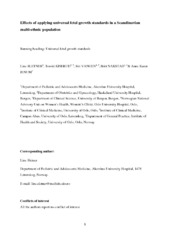| dc.contributor.author | Sletner, Line | en_US |
| dc.contributor.author | Kiserud, Torvid | en_US |
| dc.contributor.author | Vangen, Siri | en_US |
| dc.contributor.author | Nakstad, Britt | en_US |
| dc.contributor.author | Jenum, Anne Karen | en_US |
| dc.date.accessioned | 2018-08-01T06:13:53Z | |
| dc.date.available | 2018-08-01T06:13:53Z | |
| dc.date.issued | 2018-02 | |
| dc.Published | Sletner L, Kiserud T, Vangen S, Nakstad B, Jenum AK. Effects of applying universal fetal growth standards in a Scandinavian multi-ethnic population. Acta Obstetricia et Gynecologica Scandinavica. 2018;97(2):168-179 | eng |
| dc.identifier.issn | 1600-0412 | |
| dc.identifier.issn | 0001-6349 | |
| dc.identifier.uri | https://hdl.handle.net/1956/17927 | |
| dc.description.abstract | Introduction: The question of whether universal growth charts can be used in multi‐ethnic settings is of general interest. The Intergrowth‐21st fetal growth and newborn size standards are suggested to represent optimal fetal growth regardless of country origin. Our aim was to examine whether women fulfilling the strict Intergrowth‐21st inclusion criteria were healthier, showed less ethnic differences in fetal growth and newborn size, and less adverse perinatal outcomes. Material and methods: Data were drawn from a population‐based multi‐ethnic cohort of 823 presumably healthy pregnant women in Oslo, Norway. We assessed differences in fetal and neonatal gestational age specific z‐scores and compared maternal health parameters, pregnancy and birth complications between pregnancies fulfilling and not fulfilling the Intergrowth‐21st criteria. Results: Only 21% of pregnancies enrolled in our cohort fulfilled the Intergrowth‐21st criteria. Fetal growth deviated substantially from the new standards, in particular for ethnic Europeans. Ethnic differences persisted in pregnancies fulfilling the criteria. In South Asian fetuses, estimated fetal weight was −0.60 SD (95% confidence interval −1.00, −0.20) lower at 24 gestational weeks, and birthweight was −0.62 SD (−0.95, −0.29) lower, compared with ethnic Europeans. Corresponding numbers for Middle‐East/North Africans were −0.13 (−0.62, 0.36) and −0.60 (−1.00, −0.20). Maternal health indicators and birth complications were similar in women fulfilling and not fulfilling the criteria, but the relation depended on ethnic origin. Conclusions: In an urban multi‐ethnic Norwegian population, applying an extensive list of criteria to define “healthy” pregnancies excludes the majority of women but does not cancel ethnic differences in fetal growth. | en_US |
| dc.language.iso | eng | eng |
| dc.publisher | Wiley | eng |
| dc.subject | Ultrasound biometry | eng |
| dc.subject | fetal growth | eng |
| dc.subject | newbornsize | eng |
| dc.subject | ethnic differences | eng |
| dc.subject | maternal health | eng |
| dc.subject | birthcomplications | eng |
| dc.subject | growth standards | eng |
| dc.title | Effects of applying universal fetal growth standards in a Scandinavian multi-ethnic population | en_US |
| dc.type | Peer reviewed | |
| dc.type | Journal article | |
| dc.date.updated | 2018-03-13T20:50:50Z | |
| dc.description.version | acceptedVersion | en_US |
| dc.rights.holder | Copyright 2017 Nordic Federation of Societies of Obstetrics and Gynecology | |
| dc.subject.hrcs | Forplantning og fødsel: Biologiske og indre faktorer | |
| dc.subject.hrcs | Reproductive Health and Childbirth: Biological and endogenous factors | |
| dc.identifier.doi | https://doi.org/10.1111/aogs.13269 | |
| dc.identifier.cristin | 1540567 | |
| dc.source.journal | Acta Obstetricia et Gynecologica Scandinavica | |
| dc.source.pagenumber | 168-179 | |
| dc.relation.project | Helse Sør-Øst RHF: 2014004 | |
| dc.subject.nsi | VDP::Medisinske fag: 700::Klinisk medisinske fag: 750::Gynekologi og obstetrikk: 756 | |
| dc.subject.nsi | VDP::Midical sciences: 700::Clinical medical sciences: 750::Gynaecology and obstetrics: 756 | |
| dc.subject.nsi | VDP::Medisinske fag: 700::Klinisk medisinske fag: 750::Pediatri: 760 | |
| dc.subject.nsi | VDP::Midical sciences: 700::Clinical medical sciences: 750::Paediatrics: 760 | |
| dc.identifier.citation | Acta Obstetricia et Gynecologica Scandinavica. 2018;97(2):168-179 | |
| dc.source.volume | 97 | |
| dc.source.issue | 2 | |
